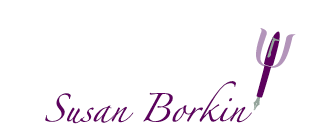Writing From The Inside Out: Using a Journal for Personal Growth & Transformation
This chapter is excerpted from Writing From the Inside Out: Using a Journal for Personal Growth & Transformation by Susan Borkin.
-
-
To go directly to the exercise on How to Use Free Form Writing, click here.

Chapter Three: Free Form Writing
If writing a perfect journal entry is what stops you from using the journal at all, you are in for very good news. The Free Form entry is designed to be written with no structure or form whatsoever.
No structure or form means there are no rules. No rules means, you simply can't do it wrong! Incomplete sentences and thoughts are fine here. No red pen will correct your grammar or syntax. Creative spelling is invited. Free Form writing not only releases you from traditional writing blocks, it can help you become more centered and aware quickly and painlessly. In a word, it's foolproof.
The structure-free nature of Free Form writing is what allows it to go in almost any direction and is exactly what creates so many more options. When you have fewer limits and restrictions, you have more possibilities and choices. Remember that increasing options is what allows you to more easily create change.
Nothing New Under the Sun
Certainly Free Form writing is not a new concept. It has been used most notably in literature by James Joyce in Ulysses as well as more contemporary authors such as Erich Maria Remarque in All Quiet on the Western Front.
In literature this form of writing is known as Stream-of-Consciousness. Here the author takes the liberty of not following normal rules of punctuation and sentence structure. The words in this format better reflect how most of us really think, moving around from one thought to another, questioning, repeating, and exploring open-ended thoughts, phrases and feelings. We often think in spurts and fragments, not complete sentences.
In psychological terms, this form of thinking is known as Free Association. Sigmund Freud originally used this method in the practice of psychoanalysis. The creator of the "Talking Cure," Freud believed that when feelings, ideas and emotions are allowed to emerge spontaneously from the unconscious, repressed traumatic experiences come into awareness.
Similar to the psychoanalytical technique described above, Free Form writing fits naturally into the context of journal writing as used throughout this book --- awareness to increase self-knowledge and therefore enhancing the ability to create change. By not editing or interrupting the natural process and flow of awareness, what was unconscious can become conscious.
Free Form Writing by Any Other Name
In the current works on journal writing or related creative writing techniques, several others have used some form of Free Form writing. Peter Elbow in Writing With Power and Bruce Ballenger and Barry Lane in Discovering the Writer Within describe a method called freewriting. Essentially they encourage the writer to keep moving the pen, to write without thinking or censoring, to allow tangents, to relax and have fun. Christina Baldwin in her book entitled One to One: Self Understanding Through Journal Writing calls a related technique flow writing. She describes a two-step approach beginning with focusing on a particular idea or thought and then allowing the writing process to increase awareness.
Natalie Goldberg in Writing Down the Bones: Freeing the Writer Within, calls this sort of writing a timed exercise, the basic unit of writing practice. She advocates these straightforward and clear rules: "keep your hand moving, don't cross out, don't worry about spelling, punctuation, or grammar, lose control, don't think, don't get logical, go for the jugular."
Free intuitive writing is one of the basic diary devices presented by Tristine Rainer in The New Diary. The method "releases the voice of the subconscious by removing or putting aside the control of the conscious mind." You relax, empty your mind and wait for whatever comes up. Rapidwriting, letting the words spill out without stopping to critique or correct or rearrange for the purpose of separating out the process of writing as opposed to editing, is described by Henriette Anne Klauser in Writing on Both Sides of the Brain.
All of these approaches essentially describe the same thing: this unstructured, formless flow of writing allows the writer to increase awareness by exploring as deeply as possible with no restrictions. The more open-ended the form, the more valuable is the tool for exploration, growth and transformation.
How Free Form Writing Works
My proposed method, Free Form writing, combines many of the characteristics of these related forms as well as deepening the awareness process. It is both free from rules and lacking in form and restrictions. Free Form writing allows your inner material to freely emerge from the unconscious, unedited.
The purpose of Free Form writing is to begin with the current awareness and move progressively deeper. The process itself is simply a recording on paper of the current flow of thoughts, feelings and awarenesses. But it is the combination of the writing itself, slowing down and tuning in to the body and senses, as well as deepening of the breathing, that serves to increase the awareness. In the vernacular of gestalt therapy, it is moving focus from what is currently in the background of the awareness (what is unaware) to bringing the awareness to the foreground. In workshops, I have described this method of writing as "an awareness continuum on paper." Shifting awareness in this way can bring about increased clarity, resulting in a more focused, present, and centered feeling.
Note that in Free Form writing, no punctuation is necessary. No attention to particular details or correct syntax nor spelling is important...only the flow of the feeling. If you imagine a swirl of paint, free flow writing gives an impression of color, line and depth without necessarily having any real direction or confining sort of outline or structure.
To create a visual image of Free Form writing, imagine yourself with a large piece of paper, flow pen in hand, and an uninterrupted thought, every word literally connected. By unlocking the tight structure of the writing, you allow a flow of formerly unconscious awareness to surface. In doing so, you increase your awareness and make formerly unconscious feelings and thoughts available and accessible to create new options.
When to Use Free Form Writing
Use Free Form Writing anytime you feel scattered, "spacey" or out-of-focus. Remember, if you feel stuck or uncomfortable or lost in any way, write that out, as well.
Amy, a regular journal writer, shares her Free Form entry:
"It feels good to just be sitting here, at last. I feel Like I have been running in circles and not getting anywhere. I have a vague sense of uneasiness or uncomfortableness, and just feel sort of out-of-touch or something. I think I'll just become very quiet now and let myself slow down, and do some deep breathing. There, that feels better now. So what am I noticing? The birds! Wow! Were they here before? Of course, they were, I didn't hear them, too spaced out. Now I hear people across the lake. Their voices rise and fall like waves of sound around me. There is a rhythm now, a rhythm as regular as my own breathing..."
How to Use Free Form Writing
To write an entry using Free Form writing, you'll find it easy to follow these basic steps:
-
Begin by closing your eyes.
-
Breath slowly and deeply (if you are not already doing so, let your stomach inflate on the inhale, and deflate on the exhale).
-
Loosen clothing that feels tight or uncomfortable.
-
Remove shoes if you'd be more comfortable.
-
When you are feeling relaxed, begin writing.
-
Allow your writing to flow without your internal editor, judge, or critic.
-
Write without blocking or stopping yourself.
-
Write exactly what comes up for you, what you are aware of, feeling or thinking.
-
Don't worry about punctuation, grammar or syntax; allow your spelling to be creative.
-
What you are writing does not need to make sense.
-
If one thought seemingly interrupts another, simply allow that to happen; let your thoughts bounce off each other, mingle or just remain as they are.
-
Let questions remain unanswered, let thoughts be incomplete.
-
If you become stuck in this exercise, write that out, notice what happens when you acknowledge exactly where you are.
-
Continue with this exercise for at least ten minutes, longer if you wish.
Try writing a Free Form entry now.
* * *
Free Form Writing Revisited
Free Form writing is a wonderful jump-start method to begin your journal if you haven't written in a while or if you don't know where to begin. Its freedom, deliberate lack of definitive direction and sense of flow may put your internal critic out of job!
return to top
|




